“In addition to Nordic runic inscriptions, the platform includes runic inscriptions in Nordic languages from Great Britain and even from Russia, Ukraine, and Turkey,” says Marco Bianchi of the Department of Scandinavian Languages, who has coordinated the project within Uppsala University and with the Swedish National Heritage Board.
Based on existing database
In the 1980s, the Department of Scandinavian Languages began working on gathering and digitising all Swedish runic inscriptions, and subsequently all other Nordic runic inscriptions. The result of this endeavour was the Scandinavian Runic Text Database, which was wholly aimed at researchers.
“Runestone researchers loved the old database, but it was less popular among those without prior knowledge in the field. We wanted to retain our target audience, i.e. runestone researchers, while also expanding the service so that it serves others engaged in related fields such as historians, archaeologists, religion historians and anyone else with an interest in runes who wants to use and enjoy the material,” says Marco Bianchi.
New user interface
Working in partnership with University IT Services, the new, modern systems were developed. These include a new administrator user interface that makes it possible to add new material, and a technical user interface that supplies the public user interface provided by the Swedish National Heritage Board with material.
“We didn’t want to copy another database – we wanted to retain our own. The public user interface acts as the hub, communicating with a range of other systems. It’s been tough at times during the project, but everyone is glad that it’s working,” says Marco Bianchi.
The challenge of different technologies
One of the people to has worked on the technological side is systems developer Peter Jaric. Apart from the difficulty of syncing the different systems, he says that the challenge was learning to work with the different technologies that were ultimately chosen.
“We had to do everything from scratch. We looked at other things we had worked on and were able learn from that and improve on them. Beforehand, we sat down and discussed what the users wanted, which kinds of things needed to be included and whether there needed to be more or less of anything in particular,” says Peter Jaric.
Digitised research materials
Another key part of the project has been making research materials available that are currently housed in the extensive collections at Carolina Rediviva in the Uppsala University Library system. The result is that research materials going back several centuries are now available in digitised form. The oldest notes date to the late sixteenth century.
“Uppsala University Library is home to the papers and photographs left by many distinguished professors. Thanks to the materials relevant to this project having been ‘tagged’ by Marco, who is a specialist in the field, it will now be possible for many other people to make use of them,” says Anna Fredriksson from the University Library.
Materials now available digitally include parts of the Otto von Friesen archive. He was Professor of Swedish Language at Uppsala University from 1906 until 1935 and he spent his summers cycling around Sweden investigating runestones. Following his death in 1942, his collection of material was donated to the Library where it is now stored in 21 archive boxes.
